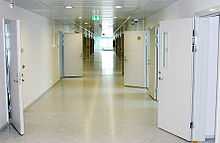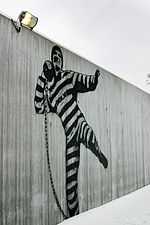Halden Prison
 Interior of the prison | |
| Location | Halden, Norway |
|---|---|
| Coordinates | 59°8′25.703″N 11°17′11.55″E / 59.14047306°N 11.2865417°ECoordinates: 59°8′25.703″N 11°17′11.55″E / 59.14047306°N 11.2865417°E |
| Status | Operational |
| Security class | Maximum |
| Capacity | 248–252 (see notes) |
| Population | 136 (as of 2010[1]) |
| Opened | April 8, 2010 |
| Managed by | Norwegian Correctional Services |
| Governor | Are Høidal |
| Website | www.haldenfengsel.no |
Halden Prison (Norwegian: Halden fengsel) is a maximum-security prison in Halden, Norway. Established in 2010, it was created with a focus on rehabilitation that is reflected in its design. Its design is projected to help inmates reintegrate into society easily by simulating life outside the prison. With the same purpose, there are several activities available to the prisoners that vary from sports to music. Also, they are stimulated to interact with the non-armed staff to create a sense of community. Praised for its humane conditions, design and architecture, it has also received criticism from the Norwegian right-wing Progress Party.
Overview
Located in Halden, Østfold, Norway,[2] Halden Prison was built with 1.5 billion Norwegian kroner ($252 million/£15 million) and was constructed over 10 years.[3][4] The prison received its first inmates on March 1, 2010[5] but was officially opened on April 8 by the Norwegian King Harald V.[6] With a capacity of 248–252 prisoners[note 1] and a site of 75 acres (30 ha),[3] it is the second largest prison in Norway.[9] A maximum-security prison,[9] it hosts dangerous and high dangerous criminals,[10] which includes rapists, murderers and pedophiles.[11] It has safety glass,[8] a 6 meter × 1.5 kilometer (6.5 yd × 1 mi) concrete and steel wall,[8][9] and a system of underground tunnels which guards use to walk through the prison.[9]
Design

The prison was projected by the Danish Erik Møller Architects and the British HLM Architects, which were selected by a competition held by the Department of Justice and the Norwegian Directorate of Public Construction and Property.[12][13][14] With a focus on rehabilitation, it was designed to simulate a village so that the prisoners can consider themselves part of society.[9] This was done because the government considers "the smaller the difference between life inside and outside the prison, the easier the transition from prison to freedom."[9]
Interiors are painted and designed to differentiate the building's areas to demarcate the differences between home, school, and workplace, for example.[15] The hallways are tiled with Moroccan tiles or have large-scale photographs that vary from daffodils to Parisian streets.[11] Exteriors are composed of bricks, galvanized steel and larch, instead of concrete, and there are trees planted.[9] The yard walls and toilet doors are decorated by a graffiti paint by the Norwegian artist Dolk,[14] which was ordered by the prison from its 6 million kroner ($1 million/£640,000) budget for art.[9][11]
Prison life
The prison's cells are 10 square metres (110 sq ft) and have a flat-screen television, a toilet, a shower, a mini-fridge, and unbarred vertical windows that let in more light.[3][11] Prisoners share kitchens and living rooms every 10–12 cells,[3] and while the prison provides the food the prisoners also can buy ingredients and make their own meal.[11] The direction encourages the inmates to take as much time as possible out of their cells.[9] Prisoners have an incentive of 53 kroner (£5.60) to leave the cells; Are Høidal, the prison's governor, stated that it is because the less activities the prisoners have, the more aggressive they become.[11] There is an "Activities House",[8] and from the period of 8 a.m. to 8 p.m, there are practices on jogging trails and in a soccer field, and woodshop, cooking and music classes offered.[3][9] At the mixing studio, the inmates also have the opportunity to record music and a monthly program broadcast by the local radio station.[11] A library with books, magazines, CDs, and DVDs, and a gym with a rock-climbing wall are also available.[16] Prisoners also receive questionnaires that ask how their prison experience can be improved.[3]
Prisoners are allowed to privately receive their families, partners or friends twice per week for two hours.[17] Individual rooms containing a sofa, sink and cupboard with sheets, towels and condoms are available for single-person visits.[17] For those with families, a larger room with toys and baby changing facilities is ready to use.[17] After visits, inmates are checked and if found in possession of illegal belongings can lose their right to a private visit.[17] This right is beforehand denied to criminals of high risk and visitors with a history of drugs offence.[17] There is also a separate chalet-style house where prisoners can receive visits from family members and stay with them for 24 hours.[3][11][17] The house has a small kitchen, two bedrooms, a bathroom, a living room with a dining table, a sofa and a television, as well as an outside play area with toys.[17] Foreigners are not allowed and inmates have to complete a child development education program to have 24-hour-long visits.[17] During this period of time, staff make regular visits to the prisoners and their families.[17]
Staff
As of 2012, Halden had 340 staff, including teachers, healthcare workers, personal trainers, and guards.[11][16] Half the guards are women. Guards eat meals and play sports with the inmates, and are typically unarmed because guns "[create] unnecessary intimidation and social distance."[3] The interaction between prisoners and the staff is stimulated "to create a sense of family,"[9] and because the staff can be "natural role models" to "motivate the inmates to develop daily routines and rhythms reminiscent of day-to-day life outside of prison walls."[8] Information is transmitted in both Norwegian and English, and there are English teachers.[11]
Impact
Halden city's inhabitants view the prison as a chance to find an employment rather than a bad thing.[9] Nina Margareta Høie of The Nordic Page stated that the prison is "known for having the most humanly conditions in Europe,"[18] while William Lee James of Time and Amelia Gentleman from The Guardian called it the world's "most humane prison."[3][11] BBC reported that HMP Grampian, a Scottish prison, "is designed and constructed for the 21st century, with a rehabilitation focus rather than punishment, closer to the model demonstrated by Halden prison in Norway."[19]
In 2010, its interior design earned the prison the Arnstein Arneberg Award.[2][20] In 2014, Michael Madsen directed a short film, exploring how its design and architecture influencens the re-socialization process, as part of Wim Wenders' 3D documentary series Cathedrals of Culture.[21][22] That same year, another film whose subject is Halden prison was produced: The Norden, a television film produced by Finnish Broadcasting Company, explored the reactions of James Conway, a former superintendent at New York's Attica Correctional Facility, in a tour through the prsion.[23][24]
Criticism has come from the conservative, right-wing populist Progress Party.[10][9] There was an increase of foreign people in Norway's prison from 8.6 percent in 2000 to 34.2 percent in 2014.[25] Per Sandberg, deputy lead of the party, attributes this to "Halden's high standard", and affirmed that Halden's facilities should only be for Norwegian citizens.[9] The party also criticized it because they considered that the quality of life in the prison was "better than in many nursing and retirement homes."[10]
See also
Notes and references
Notes
- ↑ The total capacity is contested; Statistics Norway and Norwegian Broadcasting Corporation says it is 248,[1][7] while government's official site states it is 251,[6] and Time and Northern Dimension Partnership in Public Health and Social Well-being affirms it is 252.[3][8]
References
- ↑ 1.0 1.1 "Imprisonments, 2010". Statistics Norway. March 8, 2012. Archived from the original on November 15, 2013. Retrieved December 7, 2014.
- ↑ 2.0 2.1 Foss, Ole Christian (June 22, 2010). "Halden fengsel er årets bygg i Østfold". Moss Avis (in Norwegian). Mediehuset Østfold. Archived from the original on December 8, 2014. Retrieved December 7, 2014.
- ↑ 3.0 3.1 3.2 3.3 3.4 3.5 3.6 3.7 3.8 3.9 Adams, William Lee (May 10, 2010). "Norway Builds the World's Most Humane Prison". Time (Time Inc.). Archived from the original on September 3, 2014. Retrieved July 27, 2010.
- ↑ May 11, 2010. "Luxury prison built in Norway". The Daily Telegraph. Telegraph Media Group. Retrieved December 19, 2014.
- ↑ "Correctional Services - StatRes, 2011". Statistics Norway. October 30, 2012. Archived from the original on November 15, 2013. Retrieved December 7, 2014.
- ↑ 6.0 6.1 "Melding frå Kongen til Stortinget om Noregs rikes tilstand og styring i tida etter siste melding" (in Norwegian). Regjeringen.no. October 2, 2010. Retrieved December 7, 2014.
- ↑ Prang, Rainer (May 6, 2010). "Fengsel på stort lerret" (in Norwegian). Norwegian Broadcasting Corporation. Archived from the original on December 9, 2014. Retrieved December 7, 2014.
- ↑ 8.0 8.1 8.2 8.3 8.4 "Primary Health & Prison Health Systems Expert Group - Second Meeting" (PDF). Northern Dimension Partnership in Public Health and Social Well-being. March 2011. p. 8. Archived (PDF) from the original on December 9, 2014. Retrieved December 6, 2014.
- ↑ 9.0 9.1 9.2 9.3 9.4 9.5 9.6 9.7 9.8 9.9 9.10 9.11 9.12 9.13 Adams, William Lee (July 12, 2010). "Sentenced to Serving the Good Life in Norway". Time. Time Inc. Retrieved December 19, 2014.
- ↑ 10.0 10.1 10.2 "Mehr Ferienanlage als Gefängnis". Tages-Anzeiger (in German). Tamedia. July 27, 2011. Archived from the original on September 1, 2011. Retrieved December 7, 2014.
- ↑ 11.0 11.1 11.2 11.3 11.4 11.5 11.6 11.7 11.8 11.9 11.10 Gentleman, Amelia (May 18, 2012). "Inside Halden, the most humane prison in the world". The Guardian. Guardian Media Group. Retrieved December 10, 2014.
- ↑ "Erik Møller Arkitekter: Home". ema.dk. Retrieved December 9, 2014.
- ↑ "Best of British Schools Awards Highlight HLM's Work". HLM Architects. May 17, 2012. Retrieved December 10, 2014.
- ↑ 14.0 14.1 Leung, Jennifer (August 13, 2014). "Halden Prison (Erik Møller Architects & HLM Architects)". Museum of Modern Art. Retrieved December 10, 2014.
- ↑ Pratt, John; Eriksson, Anna (2014). "Contrasts in Punishment: An Explanation of Anglophone Excess and Nordic Exceptionalism". Routledge. p. 203. ISBN 978-1-136-21700-5.
- ↑ 16.0 16.1 Masi, Alex (July 26, 2011). "The Super-Lux Super Max". Foreign Policy. Graham Holdings Company. Retrieved December 19, 2014.
- ↑ 17.0 17.1 17.2 17.3 17.4 17.5 17.6 17.7 17.8 Atkinson, Loraine (May 6, 2014). "Sex in Prison". Criminal Law & Justice Weekly 178 (18). LexisNexis. Retrieved December 18, 2014.
- ↑ Høie, Nina Margareta (February 6, 2014). "Sweden Cautious about Renting Prison Cells to Norway". The Nordic Page. Archived from the original on March 30, 2014. Retrieved December 6, 2014.
- ↑ "HMP Grampian: Transforming Scotland's Hate Factory". BBC. Retrieved December 6, 2014.
- ↑ "Designer jail: inside Norway's Halden prison - in pictures". The Guardian. Guardian Media Group. May 18, 2012. Archived from the original on December 9, 2014. Retrieved December 7, 2014.
- ↑ "Cathedrals of Culture: Halden Prison". Final Cut for Real. Archived from the original on December 8, 2014. Retrieved December 7, 2014.
- ↑ Dam, Freja (May 30, 2013). "Madsen and Redford make 3D documentary series". Danish Film Institute. Archived from the original on December 9, 2014. Retrieved December 7, 2014.
- ↑ October 19, 2014. "A Look At Life Inside Norway’s Halden Prison, Where There Are No Bars And Inmates Have Flat-Screen TVs Inside Their Cells". Inquisitr. Retrieved December 10, 2014.
- ↑ October 29, 2014. "Take A Tour Of Norway's Unbelievably Luxurious Prison". Business Insider. Business Insider Inc. Retrieved December 10, 2014.
- ↑ "Norway's 'cushy' prisons spurring foreign cons". The Local. June 2, 2014. Archived from the original on August 10, 2014. Retrieved December 7, 2014.
External links
- Official site (Norwegian)